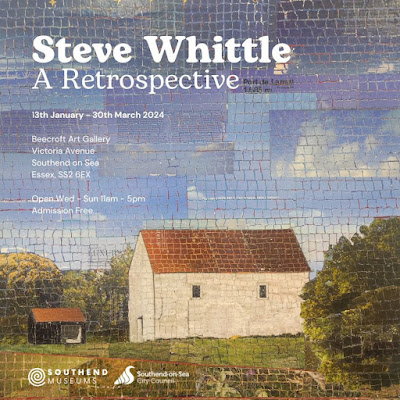There is a marvellous opportunity currently in Southend to see traditional religious imagery in a new light.
Steve Whittle ‘Retrospective : 1973-2023’
Beecroft Art Gallery
Saturday, 13 January - Sunday, 31 March 2024
The primary subject matter in Steve Whittle's work is colour, which has been the major theme. The work is often produced in series and is unified by the similar images and combinations of colours that are used. Each picture can therefore be viewed as a component of a group or seen as an individual piece.
The medium Whittle uses is collage and over many years he has developed the technique which can be seen in many of the pictures in this retrospective. Firstly the paper, which is acid free, is prepared with several coats of acrylic paint in the appropriate colour and the torn paper collage is applied to this surface with acrylic glue in as many layers as necessary to get the correct colour combinations. When the picture is complete it is then coated with UVS varnish.
The retrospective includes a series of Stations of the Cross, plus other crucifixion and resurrection images. Additionally, there are images of churches including St Peter's Chapel at Bradwell. M.L. Banting writes:
"Asking what had drawn him to this ancient Chapel, Whittle says it’s almost impossible to put into words, he’d felt a primal and immediate connection on his first visit and had to return again and again. That powerful pull has resulted in a number of works, including charcoals, pastels, paintings and collages, all of which portray the extraordinary sense, or spirit, of place – remote, lonely; glorious and powerful – the austere silhouette of the Chapel monumental against the sea and sky."
Trials and Tribulations: Modern Impressions of Iconography
Friday 2 - Thursday 29 February 2024
You can meet the artist at the following times:
- Friday 2 February, 5-6.30pm
- Saturday 3 February, 3-4.30pm
- Saturday 10 February, 11am-2pm
- Saturday 17 February, 3-5pm
- Saturday 24 February, 11am-2pm
Richard Baxter, On the Wall, 2023
on the Focal Point Gallery website, which features St Peter-on-the-Wall:
Richard Baxter is interested in how traces from previous lives of places describe time passing. When visiting a site, he collects photographic evidence and takes squeezes: sheets of porcelain pressed onto surfaces, peeled away to reveal exact negatives of specific details. He is currently exploring the site of St Peter-on-the-Wall at Bradwell in Essex. Built by Cedd in 654 it is England’s oldest church, but it uses far older materials from the Roman fort Othona that stood there for over 400 years. The stones came from Kent and the red bricks from the clay found under the fields. Many centuries have left their marks, making a complex story of building and rebuilding. It is a place of utmost simplicity requiring a simple response. The prints are enhanced with a cobalt wash, a blue associated with porcelain. This is a different kind of printmaking, and goes hand in hand with making cyanotypes, which use similar blue dye tones and give a timeless feel. This film is a collage of inputs and outcomes so far. Next steps will see Baxter combine the photographic images onto squeezes for the first time. The images will sit on top of their own texture.
----------------------------------------------------------------------------------------------------------
Low - Silver Rider.


No comments:
Post a Comment